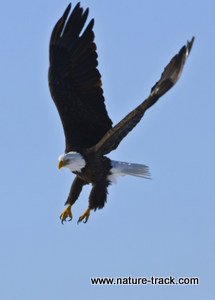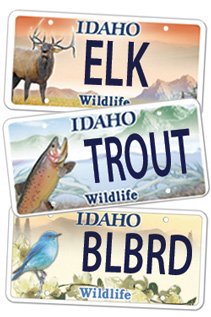Winter Bald Eagle Viewing

Bald eagles can be seen just about anywhere in south Idaho during the winter months. But if concentrations of eagles are of interest to you, check out Camas National Wildlife Refuge, The National Elk Refuge or Farmington Bay Wildlife Management Area in Utah.
Bald eagle watching and North Idaho go together like brats and kraut. In December, migrating bald eagles flock to Lake Pend Oreille and Lake Coeur d’Alene to feast on spawning Kokanee salmon. Salmon runs are ten times better in Lake Pend Oreille than they were just a handful of years ago and eagles have increased from dozens to several hundred. That rivals the glory days at Homer, Alaska when Jean Keene, the Eagle Lady, fed hundreds of eagles all winter long.
However, North Idaho is an eight hour drive away and few of us are able to take advantage of that opportunity. The December phenomenon doesn’t last either, with many of the birds winging south to places like southern Idaho, Nevada and Utah for the remainder of the winter.
In eastern Idaho we do have the South Fork of the Snake River right outside our door with the highest breeding population of bald eagles in Idaho. That means there’s a chance to see them there most of the year, including during the winter so long as access permits.
But there are a number of places where we can see bald eagles this time of year besides the South Fork. Since bald eagles are partial to a fish diet, anywhere there is open water there is an opportunity to see eagles. If ice fishing is occurring, say on Ririe Reservoir, rough fish left on the ice can attract eagles and make them easy to see.
Many bald eagles add carrion to their diet during the winter months. Winter-killed and road-killed big game can attract a number of eagles. This occasionally puts eagles in jeopardy of becoming roadkill themselves but also means that bald eagles can be found just about anywhere big game frequent. We recently visited the National Elk Refuge in Jackson where thousands of elk congregate each winter. Even in the best of winters, some elk die, providing a wonderful protein source for eagles. We saw over 20 bald eagles that day.
While seeing an eagle as a matter of happenstance is a wonderful event, seeing dozens or hundreds at a time is incredible. Fortunately, we have two areas, one very close by and another less than three hours away where we can see not only one, or even ten, eagles but rather dozens at a time.
One place is Camas National Wildlife Refuge west of Hamer. The magic happens in the evening when bald eagles roost in the cottonwood shelterbelts north of the headquarters building. During the cold snap around Christmas there were nearly 60 birds every evening. As the weather has warmed, some eagles have found different roosts but many can still be seen each evening silhouetted against the setting sun.
The second place requires a drive to Utah’s Farmington Bay Wildlife Management Area. Up to 400 eagles may congregate there taking advantage of the abundant waterbirds. In fact, February is declared Bald Eagle month and this Saturday, February 14, is Bald Eagle Day. Get more information at: http://wildlife.utah.gov/calendar.html.
So it would seem that while North Idaho eagles can give quite a show in December, it is likely these same eagles are much easier for us to see in early February.

Wildlife License Plates
Great news! as of 2024, there are three NEW designs for license plates. They still are bluebird, cutthroat trout and elk, but they are beautiful.
Idaho Wildlife license plates provide essential funding that benefits the great diversity of native plants and wildlife that are not hunted, fished or trapped—over 10,000 species or 98% of Idaho’s species diversity. Game species that share the same habitats (such as elk, deer, antelope, sage-grouse, salmon, trout) also benefit from these specialty plates.
No state tax dollars are provided for wildlife diversity, conservation education and recreation programs. Neither are any revenues from the sale of hunting or fishing licenses spent on nongame species. Instead, these species depend on direct donations, federal grants, fundraising initiatives—and the Idaho Wildlife license plates.
Both my vehicles have Bluebird Plates. I prefer the bluebird because the nongame program gets 70 percent of the money from bluebird plates, but only 60 percent of the money from elk and trout plates - 10 percent of the money from elk plates supports wildlife disease monitoring and testing programs (to benefit the livestock industry) and 10 percent from cutthroat plates supports non-motorized boat access.
Incidentally, in 2014, the Idaho Legislature denied the Department of Fish and Game the ability to add new plates or even to change the name of the elk and cutthroat plates (very specific) to wildlife and fish plates, a move that would have allowed for changing images occasionally and generating more revenue. It would seem that they believe that we Idahoans don't want a well funded wildlife program.
I think it is time we let the Legislature know that Idahoan support wildlife funding and that we would like to see these generic plates come to fruition.
Wildlife License Plates
Great news! as of 2024, there are three NEW designs for license plates. They still are bluebird, cutthroat trout and elk, but they are beautiful.
Idaho Wildlife license plates provide essential funding that benefits the great diversity of native plants and wildlife that are not hunted, fished or trapped—over 10,000 species or 98% of Idaho’s species diversity. Game species that share the same habitats (such as elk, deer, antelope, sage-grouse, salmon, trout) also benefit from these specialty plates.
No state tax dollars are provided for wildlife diversity, conservation education and recreation programs. Neither are any revenues from the sale of hunting or fishing licenses spent on nongame species. Instead, these species depend on direct donations, federal grants, fundraising initiatives—and the Idaho Wildlife license plates.
Both my vehicles have Bluebird Plates. I prefer the bluebird because the nongame program gets 70 percent of the money from bluebird plates, but only 60 percent of the money from elk and trout plates - 10 percent of the money from elk plates supports wildlife disease monitoring and testing programs (to benefit the livestock industry) and 10 percent from cutthroat plates supports non-motorized boat access.
Incidentally, in 2014, the Idaho Legislature denied the Department of Fish and Game the ability to add new plates or even to change the name of the elk and cutthroat plates (very specific) to wildlife and fish plates, a move that would have allowed for changing images occasionally and generating more revenue. It would seem that they believe that we Idahoans don't want a well funded wildlife program.
I think it is time we let the Legislature know that Idahoan support wildlife funding and that we would like to see these generic plates come to fruition.

"WOW. What a phenomenal piece you wrote. You are amazing." Jennifer Jackson
That is embarrassing, but actually a fairly typical response to my nature essays. Since The Best of Nature is created from the very best of 16 years of these nature essays published weekly in the Idaho Falls Post Register (online readership 70,000), it is a fine read. It covers a wide variety of topics including humorous glimpses of nature, philosophy, natural history, and conservation. Readers praise the style, breadth of subject matter and my ability to communicate complex and emotional topics in a relaxed and understandable manner.
Everyone can find something to love in this book. From teenagers to octogenarians, from the coffee shop to the school room, these nature essays are widely read and enjoyed.
Some of the essays here are my personal favorites, others seemed to strike a chord with readers. Most have an important message or lesson that will resonate with you. They are written with a goal to simultaneously entertain and educate about the wonderful workings of nature. Some will make you laugh out loud and others will bring a tear to the eye and warm your heart.
Readers Write:
"You hit a home run with your article on, Big Questions in Nature. It should be required reading for everyone who has lost touch with nature...great job!" Joe Chapman
"We enjoyed your column, Bloom Where Planted. Some of the best writing yet. The Post Register is fortunate to have your weekly columns." Lou Griffin.
To read more and to order a copy, click here or get the Kindle version
Copies are also available at:
Post Register
Island Park Builders Supply (upstairs)
Barnes and Noble in Idaho Falls
Harriman State Park, Island Park
Museum of Idaho
Valley Books, Jackson Wyoming
Avocet Corner Bookstore, Bear River National Wildlife Refuge, Brigham City, Utah
Craters of the Moon National Monument Bookstore, Arco, Idaho